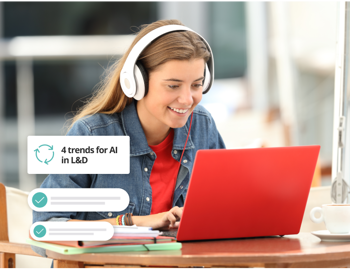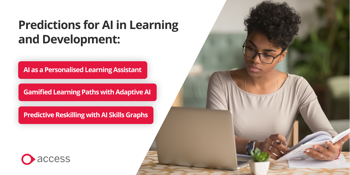
1. Shifting focus from content creation to personalised learning
While AI does well at creating content on demand, the focus is moving towards using AI in L&D to truly personalise the learning experience. Imagine an AI system that studies a learner's strengths, weaknesses, and learning preferences.
Once identified, the system can then tailor learning modules, suggest relevant resources, and even provide a virtual coach to answer questions and guide the learner through complex topics.
Let’s pull out some use cases:
- Using AI as a colleague/coach to provide feedback on learning pathway for the learner
- An AI Individual Development Plan (IDP) coach takes a learner’s experience, skills, knowledge, qualifications, interests etc. and builds a personalised individual development plan for the learner
- Utilising AI to gather the skills the business currently possesses (skills currency) and identify skills gaps, making recommendations for certifications or courses to supply to learners
The demand for efficient learning stems from learners having limited time to complete their expected training, or even feeling bad about spending part of their working day carrying it out – which is where using AI in L&D can be adopted, raising questions such as:
- How can employees learn faster?
- How can they spend their learning time most efficiently?
- How can they absorb the right things in the shortest amount of time?
With businesses and managers under pressure to use AI to be more efficient, this tailored approach can make sure learners focus on what they truly need. It can also save L&D professionals significant time and effort, allowing them to focus on higher-level tasks like designing learning experiences and providing guidance to learners.
2. AI: A partner in upskilling
Discussions at Learning Technologies highlighted an interesting link between AI and the much-discussed skills gap. Some AI models can analyse employee data to pinpoint digital skill gaps and create personalised learning paths. They can also build dynamic "skills graphs" to track individual strengths and weaknesses, empowering employees and informing strategic skills development across an organisation.
There were conversations surrounding the possibility of AI itself becoming a learning tool, with AI-powered code generation allowing employees to upskill faster potentially on the horizon. This suggests AI will not only identify skill gaps but also reshape how we learn new skills altogether.
With research suggesting that half of all skills will be outdated within two years, utilising AI tools for learning and development presents itself as a powerful partner in helping build future-proof workforces.
3. Reframing AI as a transformative tool
Another trend raised at Learning Technologies was the change in how artificial intelligence for learning can be used. With a report from Boston Consulting Group showing that consultants using AI model ChatGPT4 were more productive and higher performing than those who didn't, there is a transformative shift in how AI can be used. With this example highlighting the transformative potential of AI as a collaborator, not a replacement, it opens the door to just how powerful AI can be. Pivoting this approach to L&D, imagine how game-changing an AI model could be as a learning assistant, or your own personal L&D manager?
While we have touched upon essential AI skills and how they should be embraced within the workforce, concerns surrounding AI and potential job displacement remain. However, the conference overwhelmingly emphasised the collaborative role of AI in L&D. Research by Fosway Group also underlines this shift, with AI now impacting 30% of L&D functions. By embracing AI as a partner, L&D professionals can create a future of powerful and effective learning.
4. How AI in L&D impacts ROI
The last theme we want to highlight is how to use AI in learning and development for ROI purposes.
While initial costs may be cause for concern, the argument was raised that AI offers significant long-term value. If AI models are creating personalised learning pathways, this can greatly reduce the time employees are spending on unnecessary learning that either doesn’t serve them or is on a topic they already know well. This translates to increased efficiency and potentially higher revenue for businesses, demonstrating the return on investment in AI-powered learning.

Three predictions for AI in Learning and Development
Based on the themes we have talked about, let’s list a few ways we think learners and L&D professionals could be using AI in the next 2-5 years:
1. AI as a Personalised Learning Assistant
Move beyond static course catalogues. Imagine an AI assistant proactively recommending microlearning modules during workflows, or acting as a conversational concierge, answering skills-related questions and suggesting personalised learning paths – all tailored to the unique needs of each learner.
2. Gamified Learning Paths with Adaptive AI
AI can personalise learning journeys through gamification. Imagine a learning path for customer service representatives that adapts based on their performance in simulations. An AI coach might present progressively more challenging scenarios based on the representative’s strengths and weaknesses, keeping them engaged and optimising their learning experience.
3. Predictive Reskilling with AI Skills Graphs
AI can analyse an organisation's skills data to predict future skill requirements. This allows for proactive reskilling initiatives. The AI can create dynamic "skills graphs" for individual employees, highlighting upcoming skill gaps and recommending personalised learning paths to ensure the workforce is prepared for evolving industry demands.
The limitations of using AI tools for Learning and Development
Utilising artificial intelligence for Learning and Development offers a powerful toolkit, but it's crucial to recognise its limitations. While AI excels at data analysis and content creation, human expertise remains irreplaceable.
Learners often thrive on the engagement and insights that only Subject Matter Experts (SMEs) can provide.
At Access, we create informative eLearning content, ensuring it's always grounded in the knowledge and experience of our extensive SME network. This guarantees the highest quality learning experience that goes beyond just information delivery.
Final thoughts on how to use AI in learning and development
As we have discussed, Learning Technologies 2024 offered a glimpse into a future of L&D empowered by AI. By leveraging AI for personalisation, upskilling, and efficiency, L&D professionals can create a future of powerful and effective learning experiences and see ROI.
Access Learning can help you prepare your workforce for the future. We offer a variety of resources and solutions designed to bridge the digital skills gap and empower your learners. Explore our digital learning solutions to find out more.

 AU & NZ
AU & NZ
 SG
SG
 MY
MY
 US
US
 IE
IE